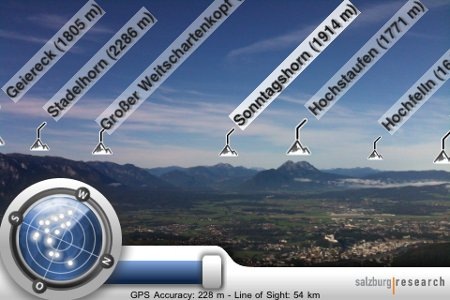 Hey What’s That goes mobile
Hey What’s That goes mobile
It’s been quite a while since I wrote about Hey What’s That?, a website that helps you identify mountains on the horizon. Well, today comes news that they have a mobile app for Android and iPhone (here is their mobile FAQ). So I tweeted about it and @CompeGPS turned me onto…
Peak.AR
Peak.AR (iTunes link) is a free augmented reality app that looks much better. There’s a screenshot at the top of this post (note that both English and German languages are supported). It’s limited to the iPhone now, but an Android app is expected by the end of February.
GPS manufacturers lag
Why can I do this with my phone, but not my handheld GPS? This is exactly the sort of thing that is leading to the demise of the industry at the hands of mobile applications. The GPS industry needs to develop a new model based on the ability to deliver innovation rapidly before free mobile apps eat their lunch.
The current model of consumer GPS receivers locks you into whatever firmware is on the device. Thus it is rare that functionality is added to the unit. Yes, Magellan gave the Meridians turn-by-turn and Garmin gave the Oregon the ability to add custom rasters as a result of firmware updates. But it is rare that such significant increases in functionality take place.
The GPS industry needs to figure out a way to let users add apps to their devices. Why should Garmin/Magellan/DeLorme be the ones to decide how we use our GPS receivers? Let us decide what capabilities to give our GPSr. Garmin has introduced those profiles, but we need something more robust. We should have a choice of geocaching apps, hunting apps, exercise apps, and cycling apps that we can download to our units. The manufacturers should give us some basic functionality, then let us decide how we want to customize our devices and tailor them to our use. Imagine if there was competition among developers to create the best apps and the market decided who succeeded.
This would kill the current marketing model of charging for a higher-end model with increased functionality or shepherding customers to a different model line based on desired functions. However, Garmin could take an Apple-like position and create an app store. Let other people develop apps for a unit, Garmin would test the app for quality, then Garmin could get a cut of the app’s sales.